30 October 2023
![]() 14 mins Read
14 mins Read
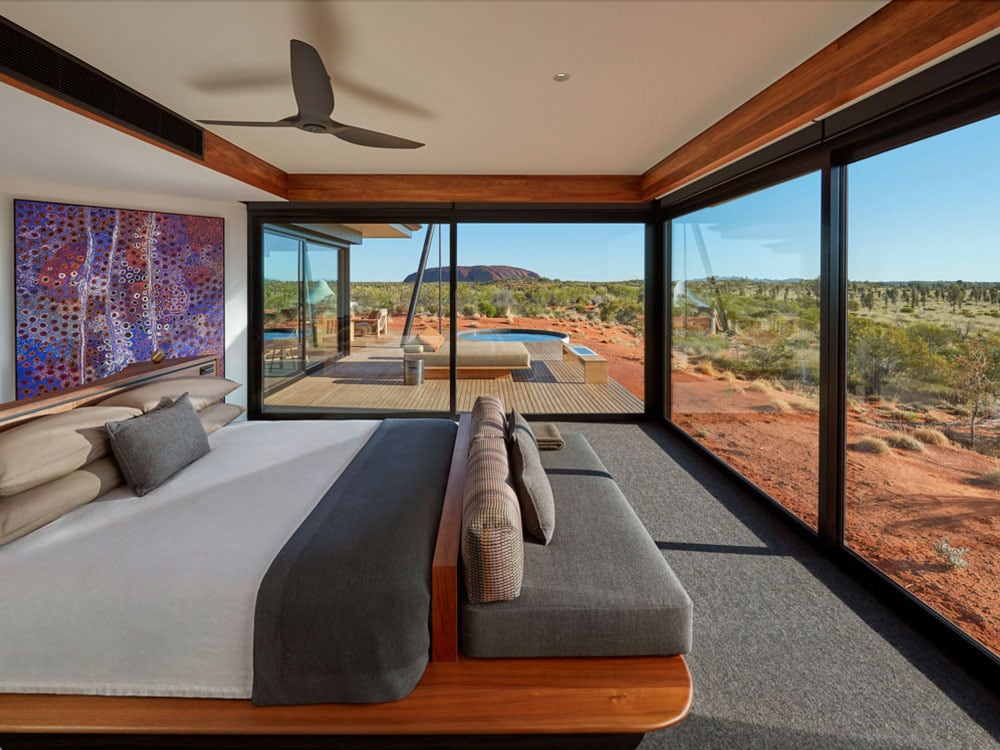
We’ve revealed our pick of 100 unique stays across Australia and below you’ll find the nine unique stays in the Northern Territory that made it into our coveted list. Head here to read the full list and start planning your next escape.
It’s only 20 minutes by air from Darwin, but you might as well be travelling to another country for all the remote, sybaritic promise offered by this sand-in-toes escape on the south-west coast of Bathurst Island– one of the Tiwis’ two main islands. There are swaying palm trees kissing soft white sand here, yes, but also a wild beauty complete with resident croc named Claudia.
Originally established as a barramundi fishing lodge, Tiwi Island Retreat’s bathroom facilities are shared and guestrooms compact. Yet, with stylish coastal-chic decor, crisp linens and views out onto the sparkling Timor Sea, what more do you need? You’re here to get off the beaten track and experience unique activities and culture in a pristine environment unlike anywhere else. Perhaps you’ll go mud crabbing or barra fishing in the creeks, eating your catch at the end of the day. Certainly you’ll spend time by the pool and linger over a sunset beach picnic stocked with cheese and champagne. And maybe you’ll embark on a remote swimming hole helicopter adventure or take a scenic flight across Bathurst Island combined with an Indigenous art and cultural tour. More than a sum of its parts, everyone who makes it here says it’s unforgettable.
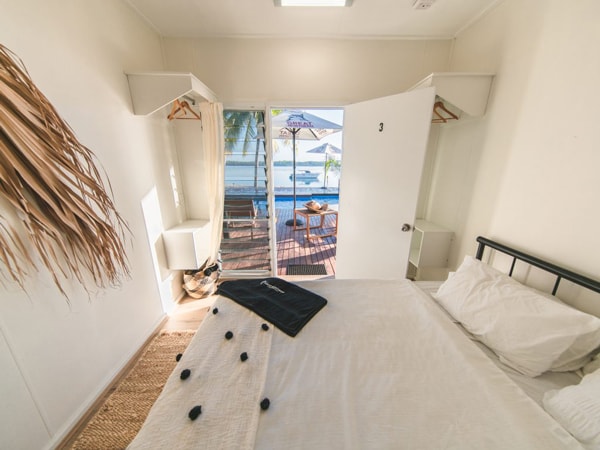
Relax in the calming, beach-inspired bedroom at Tiwi. (Image: aaronvila@iamsavi)
Set within an oasis of native gardens, Desert Gardens Hotel’s 218 guestrooms offer welcome retreat after a full day of adventuring in Uluru-Kata Tjuta National Park. You’ll want to book one of the Deluxe Rock View Rooms: the only rooms in Ayers Rock Resort with privileged views of Uluru itself that mean you can wake up to the kind of sunrise spectacle – the sacred site glowing red, and sky blazing all shades – that people put on their bucket lists. Although you can’t go wrong with a shady poolside option either, which will soon see you in cool repose under a gum-tree canopy. But the best bit about a stay here?
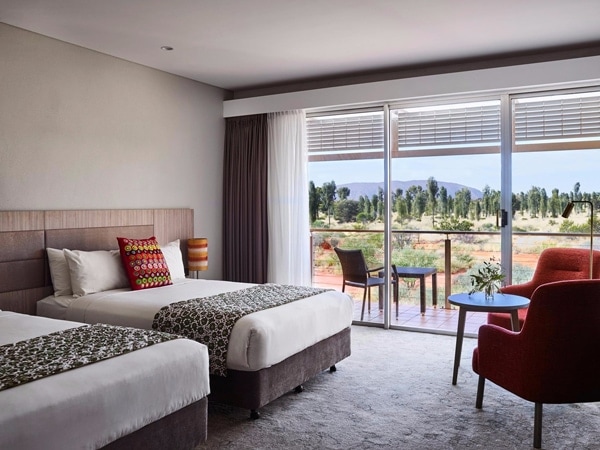
Desert Gardens Hotel is the perfect base for exploring Uluru-Kata Tjuta National Park.
The fact that it’s right next door to the brand-new Gallery of Central Australia, opened by Voyages Indigenous Tourism Australia to celebrate and showcase regional Indigenous artists. Here, you can admire more than 80 artworks supporting existing and emerging artists exclusively from the Central Australia region exhibited along with specially curated items like punu (traditional Anangu wood carving) and pieces designed and handmade by local communities.
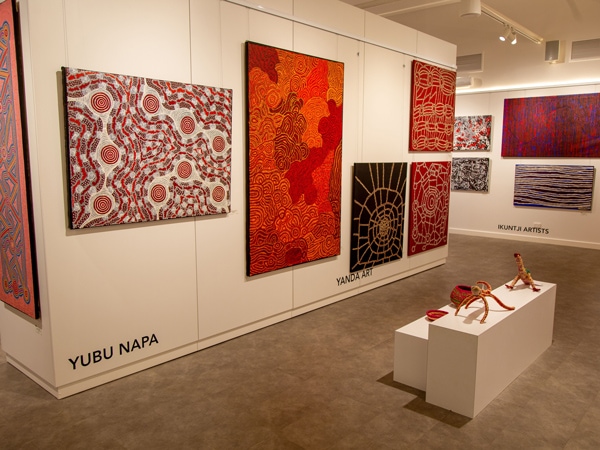
Desert Gardens Hotel is next door to the brand-new Gallery of Central Australia.
Desert Gardens Hotel forms part of Voyages Ayers Rock Resort, alongside other accommodation options like luxurious Sails in the Desert, with its brasserie-style Ilkari Restaurant, and the surprisingly edgy Lost Camel Hotel, a contemporary and fun boutique-style option. Located 20 kilometres from Uluru, Ayers Rock Campground, meanwhile, lets you get as close to nature as possible with its campsites under native desert oaks while the showstopper of the bunch, undoubtedly, is Longitude 131° – Australia’s ultimate luxury camp (pictured).
Promising days filled with dust, sweat and exhilaration is not a standard marketing hook, but in the case of Bullo River Station it is an irresistible insight into the authentic adventure that awaits. The 202,000-hectare working cattle station and homestead, in the midst of the Northern Territory’s sun-scorched landscape, offers a generous opportunity to experience life on the land, witnessing – and even assisting – as hosts Julian and Alexandra Burt maintain their 4000-strong Brahman-cross herd.
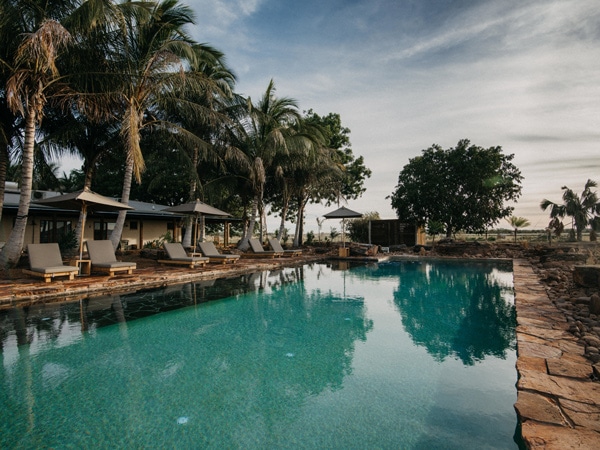
Escape the hot outback air with a dip in the pool at Bullo. (Image: Tourism NT/ Bullo River Station)
Daytime station activities here include everything from heading out on bore checks to cattle-yard work to watching cattle mustering (in season), or you can choose more sedate pastimes like fishing the Bullo River (it’s catch and release in order to protect fish stocks) or striking out on a guided tour (via all-terrain vehicle or helicopter) to Aboriginal rock art sites secreted around the property, executed by the local Miriuwung and Gajerrong people. And once the sun cools and dips towards the endless horizon, the station’s iconic homestead, sitting on a surprisingly green oasis of grass, eucalypts and boab trees, is where rest and respite is found, with cold drinks in hand and hearty communal dinners enjoyed by the campfire.
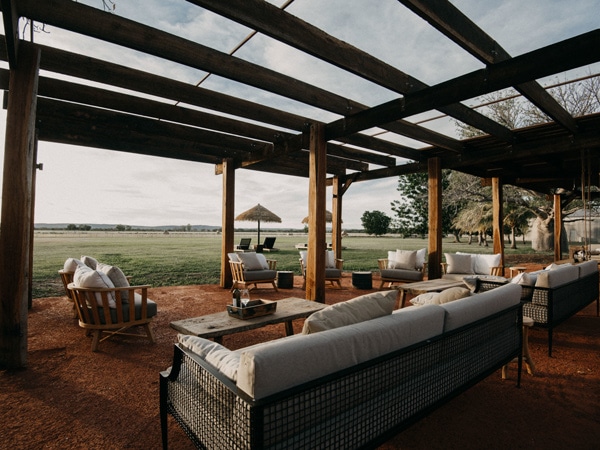
Enjoy breakfast on the deck overlooking the beautiful landscape. (Image: Tourism NT/ Bullo River Station)
The homestead and its adjacent rooms are a charming and welcoming study in rustic country/outback chic, with lots of tactile wood, leather and linen throughout. Breakfast is usually taken on the homestead’s wide verandah, before it’s time to head out into the limitless expanse of Bullo River Station to be exhilarated all over again.
You’ll need a Cessna to get here… it’ll land you on a dusty dirt airstrip just behind the lodge. The roads are near impassable in the dry season, and totally shut off in the wet. Davidson’s Arnhemland Safari Lodge at Mt Borradaile is the only accommodation on a 700-square-kilometre patch of Arnhem Land where the area’s Amurdak people have lived for at least 65,000 years (and today own and manage this registered Aboriginal sacred site). Stay in cabins amid the bush, right next to billabongs full of giant saltwater crocs, and paintings etched on caves and escarpments that are some of the oldest art on Earth. – Craig Tansley
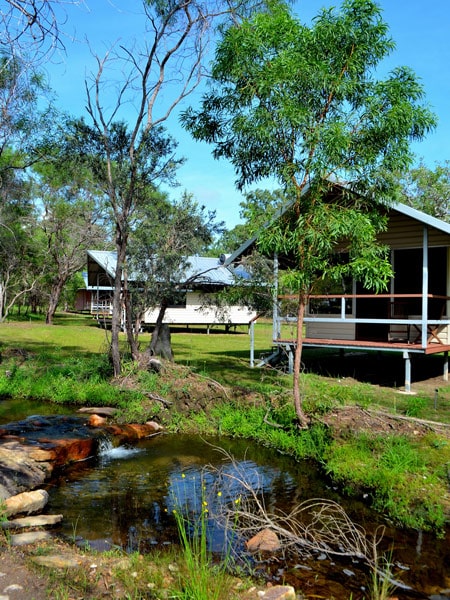
Wake up to the sound of the river running at Davidsons Safari Lodge.
It’s a race against the clock. We’re four-wheel-driving through a vast station on the fringes of Kakadu National Park originally owned by the man who inspired Indiana Jones. The odd water buffalo wallows by the wayside and I want to stop to take pictures but guide Sab Lord assures me there’ll be plenty more bovine photo ops where we’re going.
Arriving at Bamurru Plains just in time for sunset, we’re greeted warmly with a cool drink and eucalyptus-spiked face towel and ushered through the main lodge to the deck for the evening’s ritual. Sure enough, we settle in as herds of buffalo come in from the Mary River floodplains for the night. It’s a remarkable spectacle and a fitting introduction to a stay that’s all about immersion in nature.
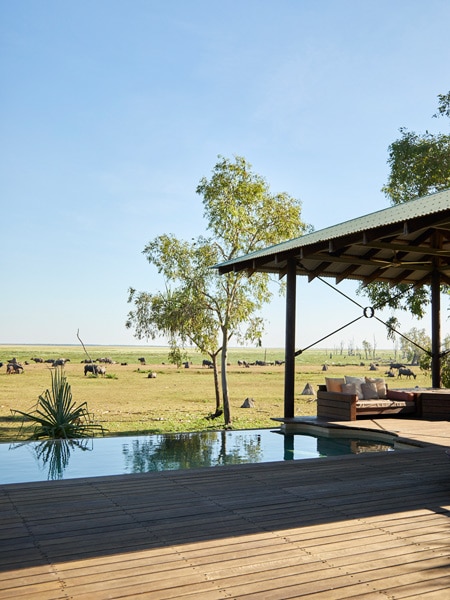
Relax and take in the scenery at Bamurru Plains. (Image: Nicky Ryan)
This Wild Bush Luxury property is built into savannah bush fringing the wetlands and, with its rustic-chic aesthetic, it espouses the kind of easygoing elegance that Australian lodges of this calibre do so well. Local-ingredient laced meals are relaxed and communal, shared with other lodge guests equally buoyed by the magic of the place; the exclusivity of the spot is divulged discreetly through touch points like the open bar. In fact, there’s a lightness of touch across everything here.
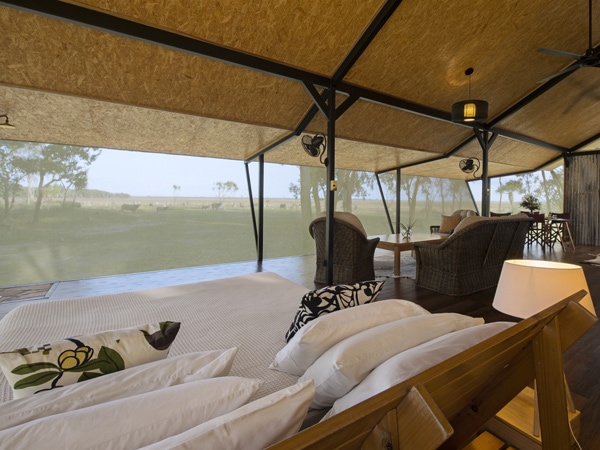
Glamp at Bamurru Plains.
And, with a responsibility towards one of Australia’s richest and most important ecosystems, not least in its environmental footprint. Measures including the mesh walls on three sides of my safari bungalow (one of 10, elevated on poles above the floodplain and blended into the bush) that help circumvent the need for air conditioning and allow you to see out without disturbing the wildlife, also serve to create the thinnest of membranes between you and this extraordinary habitat of coastal floodplains, savannah woodland and paperbark swamps. The glow of dawn seeps in through the mesh and, from the comfort of a bed wrapped in sumptuous organic linens, I have a front-row seat to the animal world waking up. Capped off by the morning’s airboat careen through the wetlands themselves, among the spike rush with the white-necked herons, pygmy geese and cormorants, the crocs in the shallows and the buffalo bathing, it’s a singular experience that never fades in my memory. – Imogen Eveson
A few days and nights staying on Country in Arnhem Land can teach your children more about Indigenous culture than they will learn in their entire school life. Lirrwi Tourism’s family-friendly Crossing Country tour and Gay’wu women’s tour – a superb mum-daughter adventure – give you quality time with Yolngu families on their traditional homelands such as Bawaka (home to resident crocodile ‘Nike’). On one of the most isolated and stunning coastlines in Australia, you can bond with several generations of these families, whose links to both the natural world and ancient culture are unshakable. Gather turtle eggs and bushfoods, and give the Yolngu language and ancient dances a try. The digs are basic but the connection to people and place is life-affirming. Crucially, your adventure helps sustain these remote cultural outposts. – Steve Madgwick
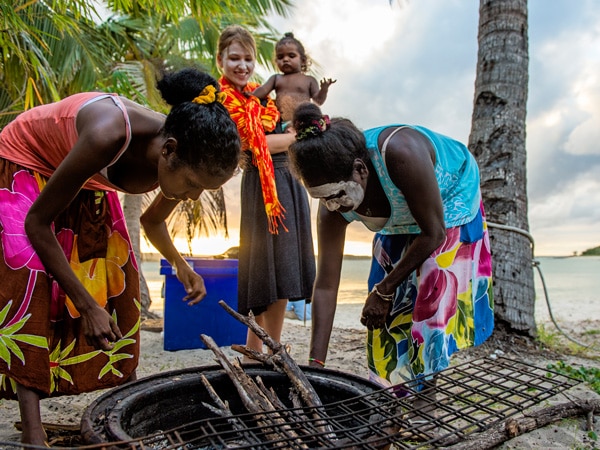
Learn about Australia’s beautiful Aboriginal culture with Bawaka tours. (Image: Shaana Mcnaught)
You’ll find garig gunak Barlu National Park at the very top of the Northern Territory: a pristine and rugged natural environment fringed with magnificent white beaches. Part of Arnhem Land’s Cobourg Peninsula, which stretches long into Arafura Sea, it might not be the first place you’d expect to find an oasis of boutique luxury. But here you have it, an iconic wilderness lodge which, when it opened in 1990, was one of the first luxury lodges in the outback.
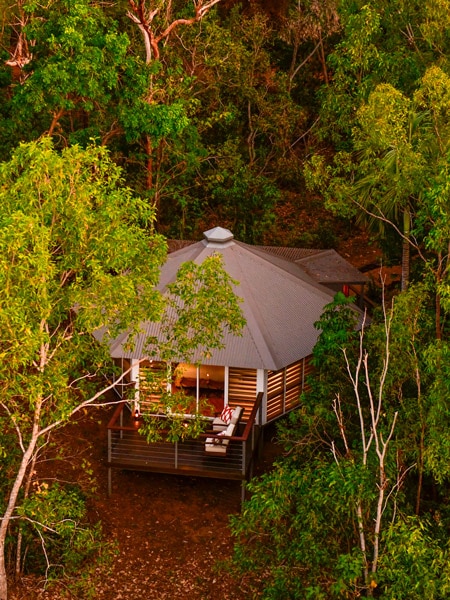
Seven Spirit hut. (Image: Steve Strike)
True to its remote location, it’s only accessible by boat or by aircraft that flies into what’s cheekily named Seven Spirit Bay International Airport; you could be forgiven for wondering if you’ve accidentally skipped the country – any further north and you’re in Indonesia. But with the tropical air fragrant with eucalyptus and the chorus of the Aussie bush all around, there’s no mistaking where you are, however far removed from everyday life this exotic hideaway feels. Seven Spirit Bay was acquired and renovated by Outback Spirit in 2015, its original ‘habitats’ transformed into 24 luxurious villas, each with an en suite and private balcony.
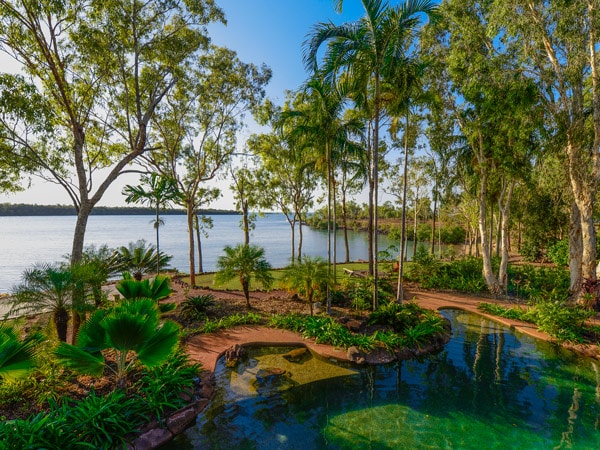
The tropical grounds of Seven Spirit Bay. (Image: Steve Strike)
Days here are spent out and about on marine adventures, 4WD wilderness safaris, fishing expeditions and bush tucker tours. Or simply cooling off in the palm-fringed lagoon pool and fine dining on the catch of the day with views over the turquoise Coral Bay. Sunsets here are of the #nofilter variety, of course.
I’m a big believer that the journey contributes to the sum of a stay’s parts, and my passage to Kings Canyon Resort makes for a spectacular equation, involving as it does a breathtaking landing past Uluru, followed by a 45-minute light-plane journey over a limitless ochre landscape punctuated by low scrub and dark green bushes scattered like windswept confetti. Landing onto a red-dirt airstrip at Kings Creek, it’s a 40-kilometre drive to finally reach the outback outpost.
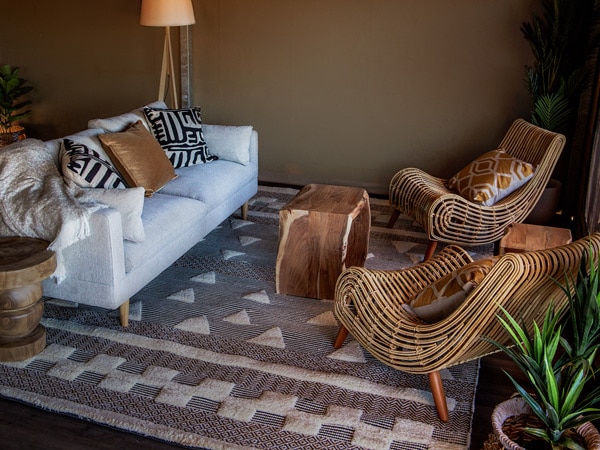
Kings Canyon earthy interior.
Situated within the 1050-square- kilometre Watarrka National Park, Kings Canyon has long lured road-trippers, who stop a while and explore the canyon’s expanses. While the resort boasts a sprawling camping ground, as well as hotel, spa and dorm-style rooms, my own journey ends as I sink into a chair on the deck of one of its luxe canvas safari-style glamping tents.
A suitable remove from the main resort, the tents are spacious and welcoming, kitted out in earthy tones, with a relaxed luxe feel. There’s a living/dining area, pillow-soft king bed and en suite bathroom complete with shower, while windows on three sides look out to the Northern Territory landscape. I trade my canvas canopy for one of abundant stars at the resort’s signature ‘Under the Moon’ degustation dinner, an outdoor affair of flavoursome dishes utilising local produce and bush tucker ingredients.
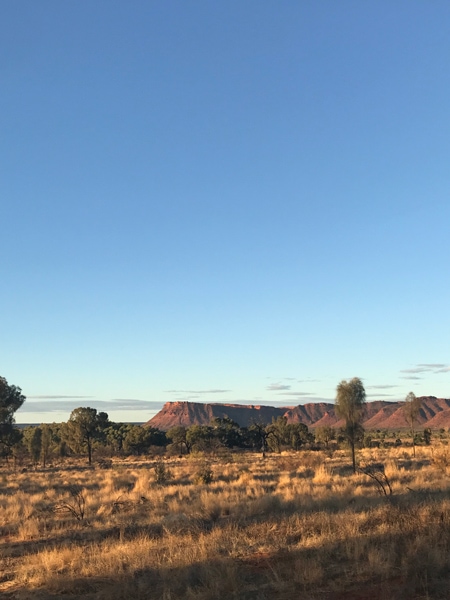
Escape the rush of life at Kings Canyon.
After the walk back to my tent by torchlight, I sink into sleep, all zipped up for the night. I wake later to the sound of howling dingoes in the distance, the canvas walls offering both a cosy shell and unfiltered access to the sounds of the surrounding environment. A highlight of Kings Canyon Resort is its irresistible proximity to the canyon itself. In spite of the outback symphony the night before, I’m up before the sun to take on the six-kilometre Rim Walk that skirts the edge of the vertiginous canyon. The walk starts with a 500-step climb, but the views out to Watarrka National Park, bathed in sunrise pinks and golds, is stunning. My trek traverses scrubby plateaus and solid red rock, and descends into the verdant oasis of the Garden of Eden, ending three hours later back where I started.
After lunch back at the resort, I head to Karrke Aboriginal Cultural Experience. Owned and operated by Christine Breaden and Peter Abbott, members of the local Wanmarra Aboriginal Community, tours here are designed to share and preserve the generous hosts’ Luritja and Pertame languages and culture. I learn about art and cultural practices, weapons (little-known fact: boomerangs in this part of Central Australia don’t return) and medicinal plants used for millennia. Combining the Rim Walk with a visit to Karrke is essential in my books; seeing the dramatic beauty of the land and then meeting the people who have called it home for a mind-bending period of time confirms how essential respecting the past is to creating a positive future for our country.
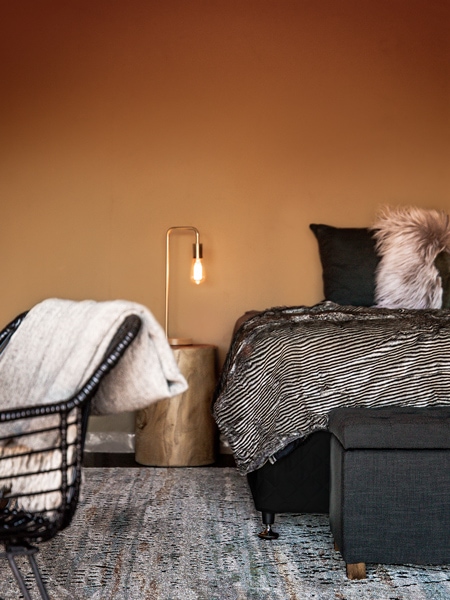
Kings Canyon bedroom detail.
After another night under canvas, my journey out of Kings Canyon Resort is taken by road. While the landscape outside the window stays largely low and uniform, a stop at Lake Amadeus/Pantu offers spectacular contrast. The salt lake’s grey and milky white expanse stretches to a hazy line on the horizon. As I stand looking across it, the wind in my ears the only sound, the full equation of my glamping stay at Kings Canyon Resort is complete. – Leigh-Ann Pow
Forget the typical donga-style tourist digs that are so common around the Northern Territory – the Latham family has raised the accommodation bar several notches, offering visitors like me a classy outback experience that won’t break the bank. Nestled at the edge of Litchfield National Park, this hideaway has a portfolio of three sleek cabins surrounded by bush, 90 minutes from Darwin. Made from 12-metre shipping containers sliced in half – producing one single-level pavilion and two double-storey spaces – each of the villas has a lounge area, fully equipped kitchen and bathrooms with rain showers.
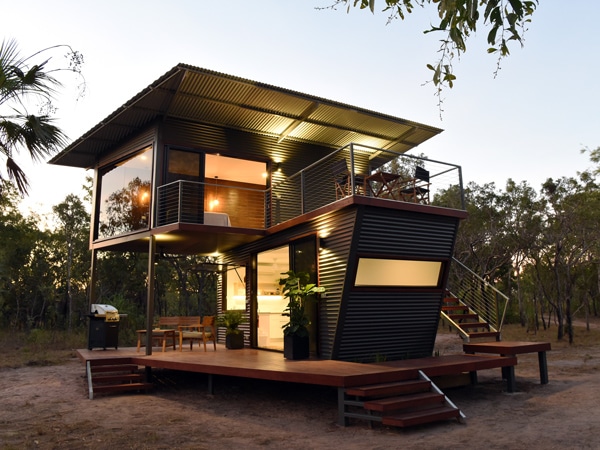
Hideaway’s luxurious cabins are made from shipping containers. (Image: Tourism NT/ Hideaway Litchfield)
Looking for a bath? I found a series of crystal-clear rock pools to relax in three kilometres down the track at Cascades, before taking a walk in the monsoon forest. A few kilometres on, I fell in love with Wangi Falls, a big name in Litchfield together with Florence Falls. Wangi has a well-marked path that I followed up the mountain and over the top of the waterfall before descending back to the cool, huge pool below. Back at ‘camp’, the Latham family have stocked the fridge with eggs and bacon, milk, and a few treats so I can skip the grocery shop for breakfast. Self-described “bushies”, Roger and Vivian built their own home on this property with the help of their sons.
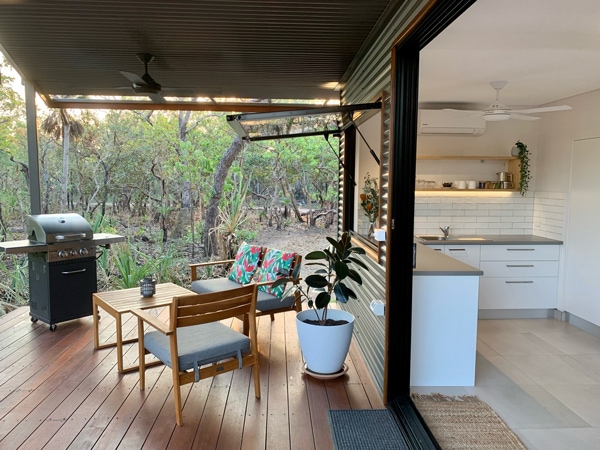
Soak in the fresh air at Hideaway. (Image: Tourism NT/ Jackson Groves)
With the popular swimming holes of Litchfield on their doorstep, the couple said it made sense to add some tourist accommodation, too. “We just love living here and we wanted to share it, so that’s how the cabins came about. All the family pitched in and helped, and we ended up with something special,” says Roger. Looking out at the kangaroos, surrounded by bush – and sipping a cold pinot gris – I couldn’t agree more with Roger. This is special. – Leah McLennan
This sounds a great place to stay. Great reeading.